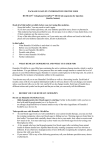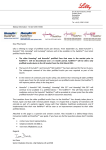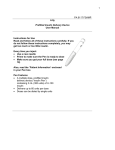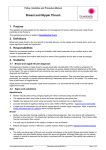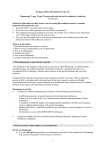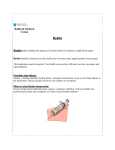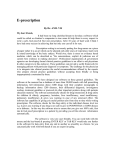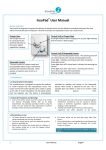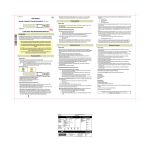Download HUMULIN N Pen
Transcript
1
PA 9132 FSAMP
INFORMATION FOR THE PATIENT
3 ML DISPOSABLE INSULIN DELIVERY DEVICE
®
HUMULIN N Pen
NPH
HUMAN INSULIN
(rDNA ORIGIN) ISOPHANE SUSPENSION
WARNINGS
THIS LILLY HUMAN INSULIN PRODUCT DIFFERS FROM ANIMALSOURCE INSULINS BECAUSE IT IS STRUCTURALLY IDENTICAL TO THE
INSULIN PRODUCED BY YOUR BODY'S PANCREAS AND BECAUSE OF ITS
UNIQUE MANUFACTURING PROCESS.
ANY CHANGE OF INSULIN SHOULD BE MADE CAUTIOUSLY AND ONLY
UNDER MEDICAL SUPERVISION. CHANGES IN STRENGTH,
MANUFACTURER, TYPE (E.G., REGULAR, NPH, LENTE, ETC), SPECIES
(BEEF, PORK, BEEF-PORK, HUMAN), OR METHOD OF MANUFACTURE
(rDNA VERSUS ANIMAL-SOURCE INSULIN) MAY RESULT IN THE NEED
FOR A CHANGE IN DOSAGE.
SOME PATIENTS TAKING HUMULIN® (HUMAN INSULIN, rDNA ORIGIN)
MAY REQUIRE A CHANGE IN DOSAGE FROM THAT USED WITH ANIMALSOURCE INSULINS. IF AN ADJUSTMENT IS NEEDED, IT MAY OCCUR
WITH THE FIRST DOSE OR DURING THE FIRST SEVERAL WEEKS OR
MONTHS.
TO OBTAIN AN ACCURATE DOSE, CAREFULLY READ AND FOLLOW
THE "DISPOSABLE INSULIN DELIVERY DEVICE USER MANUAL" AND
THIS INFORMATION FOR THE PATIENT INSERT BEFORE USING THIS
PRODUCT. (See also INSTRUCTIONS FOR PEN USE section.)
DIABETES
Insulin is a hormone produced by the pancreas, a large gland that lies near the stomach.
This hormone is necessary for the body's correct use of food, especially sugar. Diabetes
occurs when the pancreas does not make enough insulin to meet your body's needs.
To control your diabetes, your doctor has prescribed injections of insulin products to
keep your blood glucose at a near-normal level. You have been instructed to test your
blood and/or your urine regularly for glucose. Studies have shown that some chronic
complications of diabetes such as eye disease, kidney disease, and nerve disease can be
significantly reduced if the blood sugar is maintained as close to normal as possible. The
American Diabetes Association recommends that if your premeal glucose levels are
consistently above 140 mg/dL or your hemoglobin A1c (HbA1c) is more than 8%, consult
your doctor. A change in your diabetes therapy may be needed. If your blood tests
consistently show below-normal glucose levels, you should also let your doctor know.
Proper control of your diabetes requires close and constant cooperation with your doctor.
2
Despite diabetes, you can lead an active and healthy life if you eat a balanced diet, exercise
regularly, and take your insulin injections as prescribed.
Always keep an extra supply of insulin as well as a spare syringe and needle on hand.
Always wear diabetic identification so that appropriate treatment can be given if
complications occur away from home.
NPH HUMAN INSULIN
Description
Humulin is synthesized in a non-disease-producing special laboratory strain of
Escherichia coli bacteria that has been genetically altered by the addition of the human
gene for insulin production. Humulin® N is a crystalline suspension of human insulin with
protamine and zinc providing an intermediate-acting insulin with a slower onset of action
and a longer duration of activity (up to 24 hours) than that of regular insulin. The time
course of action of any insulin may vary considerably in different individuals or at different
times in the same individual. As with all insulin preparations, the duration of action of
Humulin N is dependent on dose, site of injection, blood supply, temperature, and physical
activity. Humulin N is a sterile suspension and is for subcutaneous injection only. It should
not be used intravenously or intramuscularly. The concentration of Humulin N in Humulin
N Pen is 100 units/mL (U-100).
Identification
Humulin disposable insulin delivery devices, manufactured by Eli Lilly and Company, are
available in 2 formulations--NPH and 70/30.
Your doctor has prescribed the type of insulin that he/she believes is best for you. DO
NOT USE ANY OTHER INSULIN EXCEPT ON HIS/HER ADVICE AND
DIRECTION.
The Humulin N Pen is available in boxes of 5 disposable insulin delivery devices ("insulin
pens"). The Humulin N Pen is not designed to allow any other insulin to be mixed in its
cartridge, or for the cartridge to be removed.
Always examine the appearance of Humulin N suspension in the insulin pen before
administering a dose. A cartridge of Humulin N contains a small glass bead to assist in
mixing. Humulin N Pen must be rolled between the palms 10 times and inverted 180° 10
times before each injection so that the contents are uniformly mixed (see Figures 1 and 2).
Inspect the Humulin N suspension for uniform mixing and repeat the above steps as
necessary.
Figure 1.
Figure 2.
3
Humulin N should look uniformly cloudy or milky after mixing. Do not use if the insulin
substance (the white material) remains visibly separated from the liquid after mixing. Do
not use the Humulin N Pen if there are clumps in the insulin after mixing. Do not use the
Humulin N Pen if solid white particles stick to the walls of the cartridge, giving it a frosted
appearance.
Always check the appearance of the Humulin N suspension in the insulin pen before
using, and if you note anything unusual in the appearance of Humulin N suspension or
notice your insulin requirements changing markedly, consult your doctor.
Never attempt to remove the cartridge from the Humulin N Pen. Inspect the cartridge
through the clear cartridge holder.
Storage
Humulin N Pens should be stored in a refrigerator but not in the freezer. The Humulin N
Pen that you are currently using should not be refrigerated but should be kept as cool as
possible (below 86°F [30°C]) and away from heat and light. Do not use an insulin pen if it
has been frozen. Unrefrigerated Humulin N Pens must be discarded after 2 weeks, even
if they still contain insulin. Do not use Humulin N Pens after the expiration date stamped
on the label.
INSTRUCTIONS FOR PEN USE
It is important to read, understand, and follow the instructions in the "Disposable
Insulin Delivery Device User Manual" before using. Failure to follow instructions
may result in an inaccurate insulin dose.
NEVER SHARE INSULIN PENS, CARTRIDGES, OR NEEDLES.
PREPARING THE PEN FOR INJECTION:
1. Always check the appearance of the Humulin N suspension in the insulin pen before
using.
2. Roll the Humulin N Pen between the palms 10 times (see Figure 1 above).
3. Holding the Humulin N Pen by one end, invert it 180° slowly 10 times to allow the
glass bead to travel the full length of the cartridge with each inversion (see Figure 2
above). The cartridge is contained in the clear cartridge holder of the Humulin N
Pen.
4. Inspect the appearance of the Humulin N suspension to make sure the contents look
uniformly cloudy or milky. If not, repeat the above steps until the contents are
mixed. Do not use a Humulin N Pen if there are clumps in the insulin or if solid
white particles stick to the walls of the cartridge.
5. Follow the instructions in the "Disposable Insulin Delivery Device User Manual" for
these steps:
• Preparing the Pen
• Attaching the Needle
• Priming the Pen (Checking the Insulin Flow)
• Setting (Dialing) a Dose
• Injecting the Dose
• Following an Injection
4
PREPARING FOR INJECTION:
1. Wash your hands.
2. To avoid tissue damage, choose a site for each injection that is at least 1/2 inch from
the previous injection site. The usual sites of injection are abdomen, thighs, and
arms.
3. Cleanse the skin with alcohol where the injection is to be made.
4. With one hand, stabilize the skin by spreading it or pinching up a large area.
5. Inject the dose as instructed by your doctor.
6. After dispensing a dose, pull the needle out and apply gentle pressure over the
injection site for several seconds. Do not rub the area.
7. Immediately after an injection, remove the needle from the Humulin N Pen. Doing so
will guard against contamination, leakage, reentry of air, and needle clogs. Do not
reuse needles. Dispose of needles in a responsible manner.
DOSAGE
Your doctor has told you which insulin to use, how much, and when and how often to
inject it. Because each patient's case of diabetes is different, this schedule has been
individualized for you.
Your usual insulin dose may be affected by changes in your food, activity, or work
schedule. Carefully follow your doctor's instructions to allow for these changes. Other
things that may affect your insulin dose are:
Illness
Illness, especially with nausea and vomiting, may cause your insulin requirements to
change. Even if you are not eating, you will still require insulin. You and your doctor
should establish a sick day plan for you to use in case of illness. When you are sick, test
your blood glucose/urine glucose and ketones frequently and call your doctor as
instructed.
Pregnancy
Good control of diabetes is especially important for you and your unborn baby.
Pregnancy may make managing your diabetes more difficult. If you are planning to have a
baby, are pregnant, or are nursing a baby, consult your doctor.
Medication
Insulin requirements may be increased if you are taking other drugs with hyperglycemic
activity, such as oral contraceptives, corticosteroids, or thyroid replacement therapy.
Insulin requirements may be reduced in the presence of drugs with hypoglycemic activity,
such as oral hypoglycemics, salicylates (for example, aspirin), sulfa antibiotics, and certain
antidepressants. Always discuss any medications you are taking with your doctor.
Exercise
Exercise may lower your body's need for insulin during and for some time after the
activity. Exercise may also speed up the effect of an insulin dose, especially if the exercise
involves the area of injection site (for example, the leg should not be used for injection just
prior to running). Discuss with your doctor how you should adjust your regimen to
accommodate exercise.
Travel
Persons traveling across more than 2 time zones should consult their doctor concerning
adjustments in their insulin schedule.
5
COMMON PROBLEMS OF DIABETES
Hypoglycemia (Insulin Reaction)
Hypoglycemia (too little glucose in the blood) is one of the most frequent adverse events
experienced by insulin users. It can be brought about by:
1. Taking too much insulin
2. Missing or delaying meals
3. Exercising or working more than usual
4. An infection or illness (especially with diarrhea or vomiting)
5. A change in the body's need for insulin
6. Diseases of the adrenal, pituitary or thyroid gland, or progression of kidney or liver
disease
7. Interactions with other drugs that lower blood glucose, such as oral hypoglycemics,
salicylates (for example, aspirin), sulfa antibiotics, and certain antidepressants
8. Consumption of alcoholic beverages
Symptoms of mild to moderate hypoglycemia may occur suddenly and can include:
• sweating
• drowsiness
• dizziness
• sleep disturbances
• palpitation
• anxiety
• tremor
• blurred vision
• hunger
• slurred speech
• restlessness
• depressed mood
• tingling in the hands, feet, lips, or tongue
• irritability
• lightheadedness
• abnormal behavior
• inability to concentrate
• unsteady movement
• headache
• personality changes
Signs of severe hypoglycemia can include:
• disorientation
• seizures
• unconsciousness
• death
Therefore, it is important that assistance be obtained immediately.
Early warning symptoms of hypoglycemia may be different or less pronounced under
certain conditions, such as long duration of diabetes, diabetic nerve disease, medications
such as beta-blockers, change in insulin preparations, or intensified control (3 or more
insulin injections per day) of diabetes.
A few patients who have experienced hypoglycemic reactions after transfer from
animal-source insulin to human insulin have reported that the early warning
symptoms of hypoglycemia were less pronounced or different from those
experienced with their previous insulin.
Without recognition of early warning symptoms, you may not be able to take steps to
avoid more serious hypoglycemia. Be alert for all of the various types of symptoms that
may indicate hypoglycemia. Patients who experience hypoglycemia without early warning
symptoms should monitor their blood glucose frequently, especially prior to activities such
as driving. If the blood glucose is below your normal fasting glucose, you should consider
eating or drinking sugar-containing foods to treat your hypoglycemia.
Mild to moderate hypoglycemia may be treated by eating foods or drinks that contain
sugar. Patients should always carry a quick source of sugar, such as candy mints or
glucose tablets. More severe hypoglycemia may require the assistance of another person.
6
Patients who are unable to take sugar orally or who are unconscious require an injection
of glucagon or should be treated with intravenous administration of glucose at a medical
facility.
You should learn to recognize your own symptoms of hypoglycemia. If you are
uncertain about these symptoms, you should monitor your blood glucose frequently to
help you learn to recognize the symptoms that you experience with hypoglycemia.
If you have frequent episodes of hypoglycemia or experience difficulty in recognizing the
symptoms, you should consult your doctor to discuss possible changes in therapy, meal
plans, and/or exercise programs to help you avoid hypoglycemia.
Hyperglycemia and Diabetic Acidosis
Hyperglycemia (too much glucose in the blood) may develop if your body has too little
insulin. Hyperglycemia can be brought about by:
1. Omitting your insulin or taking less than the doctor has prescribed
2. Eating significantly more than your meal plan suggests
3. Developing a fever, infection, or other significant stressful situation
In patients with insulin-dependent diabetes, prolonged hyperglycemia can result in diabetic
acidosis. The first symptoms of diabetic acidosis usually come on gradually, over a period of
hours or days, and include a drowsy feeling, flushed face, thirst, loss of appetite, and fruity odor
on the breath. With acidosis, urine tests show large amounts of glucose and acetone. Heavy
breathing and a rapid pulse are more severe symptoms. If uncorrected, prolonged hyperglycemia
or diabetic acidosis can lead to nausea, vomiting, dehydration, loss of consciousness or death.
Therefore, it is important that you obtain medical assistance immediately.
Lipodystrophy
Rarely, administration of insulin subcutaneously can result in lipoatrophy (depression in
the skin) or lipohypertrophy (enlargement or thickening of tissue). If you notice either of
these conditions, consult your doctor. A change in your injection technique may help
alleviate the problem.
Allergy to Insulin
Local Allergy--Patients occasionally experience redness, swelling, and itching at the site
of injection of insulin. This condition, called local allergy, usually clears up in a few days
to a few weeks. In some instances, this condition may be related to factors other than
insulin, such as irritants in the skin cleansing agent or poor injection technique. If you have
local reactions, contact your doctor.
Systemic Allergy--Less common, but potentially more serious, is generalized allergy to
insulin, which may cause rash over the whole body, shortness of breath, wheezing,
reduction in blood pressure, fast pulse, or sweating. Severe cases of generalized allergy
may be life threatening. If you think you are having a generalized allergic reaction to
insulin, notify a doctor immediately.
7
ADDITIONAL INFORMATION
Additional information about diabetes may be obtained from your diabetes educator.
DIABETES FORECAST is a national magazine designed especially for patients with
diabetes and their families and is available on subscription from the American Diabetes
Association, National Service Center, 1660 Duke Street, Alexandria, Virginia 22314, 1800-DIABETES (1-800-342-2383).
Another publication, DIABETES COUNTDOWN, is available from the Juvenile
Diabetes Foundation, 120 Wall Street 19th Floor, New York, New York 10005-4001, 1800-JDF-CURE (1-800-533-2873).
Additional information about Humulin and Humulin N Pen can be obtained by calling 1888-88-LILLY (1-888-885-4559).
Literature revised August 3, 2000
Manufactured by Lilly France S.A.
F-67640 Fegersheim, France
for Eli Lilly and Company
Indianapolis, IN 46285, USA
PA 9132 FSAMP
Copyright © 1998, 2000, Eli Lilly and Company. All rights reserved.







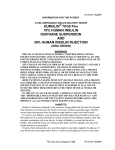
![[Product Monograph Template - Standard]](http://vs1.manualzilla.com/store/data/005786637_1-bbde87d0b5b85ef8c8ff6a7fd943fd08-150x150.png)


